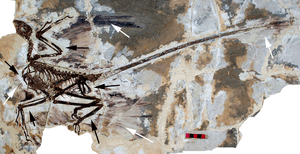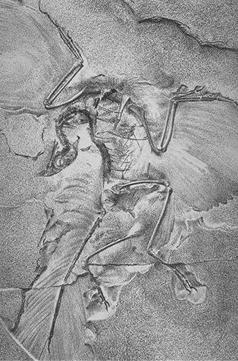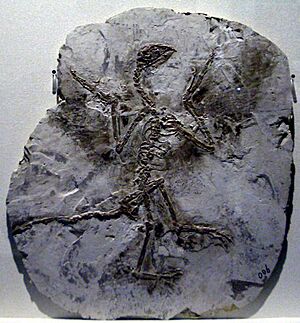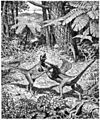Origin of birds facts for kids
The origin of birds is a super interesting question in palaeontology (the study of fossils) and evolution. Scientists believe that birds evolved from a group of dinosaurs called theropods. This happened during the Mesozoic Era, which was a very long time ago.
About 150 years ago, a scientist named Thomas Henry Huxley (who was a friend of Charles Darwin) studied this. He compared the very first fossil bird ever found, called Archaeopteryx, with a small theropod dinosaur named Compsognathus. Both fossils were found in the same place and from the same time period: the Solnhofen Limestone in Bavaria, Germany. These rocks are from the end of the Jurassic period, about 144 million years ago.
Huxley's studies showed that Archaeopteryx and Compsognathus looked almost exactly alike. The main differences were the front limbs and feathers of Archaeopteryx. He suggested that birds had evolved from small meat-eating dinosaurs.
Contents
Modern Discoveries
For a long time, scientists agreed that Archaeopteryx came from reptiles. But many thought it came from an older type of reptile than dinosaurs. Eventually, almost all scientists agreed with Huxley. They now think that early members of a group of small meat-eating dinosaurs were the ancestors of birds.
The group of dinosaurs most likely to be bird ancestors is called Paraves or Eumaniraptora. This group includes dromaeosaurs (like Velociraptor and Deinonychus) and troodonts. It would have been an earlier type of dromaeosaur, perhaps from the lower Jurassic period. Dromaeosaurs have many features that we used to think only birds had. These include hollow bones with holes for air-sacs, limbs with many bones either missing or joined together, clavicles (collarbones) fused into wishbones, and feathers.
The discovery of feathered dinosaurs and early birds in China finally convinced many scientists. It seems that theropod dinosaurs first developed feathers to help them stay warm, not to fly. Then, a small group of these dinosaurs started to use their feathers for simple flight. Archaeopteryx and Anchiornis are examples of this group from the Jurassic period.
A Mix of Old and New Features
Huxley noticed that Archaeopteryx had a mix of reptile and bird features. Without its feathers and arms, its skeleton looked just like Compsognathus. We now know that Archaeopteryx's bones grew much slower than modern birds. This means it took longer for it to be able to fly after hatching. A modern bird that can walk and feed itself soon after hatching might fly in 3–6 weeks. But Archaeopteryx might have taken about 18 weeks. It could have taken two to three years to reach its full adult size.
This is an example of mosaic evolution. This means that in a transitional form (a fossil that shows features of both its ancestors and its descendants), some features are very old, while others are surprisingly modern.
Amazing Chinese Bird Fossils
Jurassic Period Fossils
Anchiornis huxlei is the only "dinobird" fossil found so far that lived before Archaeopteryx. It was discovered in Liaoning, China. The rocks where it was found are from the mid-to-late Jurassic period, about 160 to 155 million years ago. There are also other feathered dinosaurs from the Jurassic of China that couldn't fly, like the maniraptoran Epidexipteryx. Epidexipteryx is the earliest known example of fancy, showy feathers in the fossil record, from about 152 to 168 million years ago.
Anchiornis had large wings. These wings were made of flight feathers attached to its arms and hands, just like modern birds. It also had flight feathers on its back legs, making it look like it had four wings. The front wing of Anchiornis had 11 main feathers and 10 secondary feathers. Its primary feathers were not as good for flying as those of its later relatives. In Microraptor and Archaeopteryx, the longest wing feathers were at the tip, making the wings long and pointed. But in Anchiornis, the longest feathers were near the wrist. This made its wings wider in the middle and narrower at the tip, giving them a more rounded shape, less suited for strong flight. So, Anchiornis could probably glide, but not truly fly.
Cretaceous Period Fossils

Learning to fly helped birds find many new habitats (places to live). This led to a rapid burst of evolution, where many new bird types appeared. We can see this in the Chinese fossils from the Lower Cretaceous period. These fossils are more varied and often more advanced than Archaeopteryx. There are now 31 different bird genera (groups of species) found from the Lower Cretaceous of China.
It's also clear from the tail feathers of Confuciusornis (one of the Chinese fossils) that some of these birds were already using feathers for showing off or communicating, just like birds do today. Like staying warm, using feathers for display might have happened much earlier than flight. Confuciusornis is the fifth oldest bird fossil, appearing about 25 million years after Archaeopteryx.
Most dinosaurs died out in a huge extinction event at the end of the Cretaceous period, about 66 million years ago. The only ones that survived were the birds. This means birds are not just related to reptiles, but they are direct descendants of theropod dinosaurs. Birds are the last surviving dinosaurs!
Colour of Feathers
Scientists have even figured out the colors of feathers from a 120-million-year-old fossil bird! They used X-rays to scan beautifully preserved fossils of Gansus yumenensis and Confuciusornis sanctus. Their study found the chemical "fingerprint" of pigments that once colored the ancient bird's feathers. For example, the metal copper is a sign of a dark pigment called eumelanin. The X-ray technique was so sensitive that it could show how each copper molecule was shaped because it was part of a eumelanin molecule. This type of research has now been done many times.
Dinobirds
"Dinobirds" is a casual name for the theropod dinosaurs that are most closely related to birds. These are usually small dinosaurs. They definitely had special feathers, like those of birds, which means they probably could control their body temperature. One way to group them is:
- Eumaniraptora or Paraves
- Deinonychosauria
- Aves (which means birds)
The earliest known dinobird is a troodont called Anchiornis huxlei, from the Upper Jurassic period. This fossil is 5–10 million years older than Archaeopteryx. It also came before any other feathered dinosaur found in its area (Liaoning Province, China) by 25–35 million years. This species had long feathers on its back legs as well as its front limbs. It could glide, but probably not truly fly.
So, at least this group of theropod dinosaurs had well-developed, real feathers before the first known bird appeared. It's still not certain if other groups of theropods had feathers. One dinosaur, Sinosauropteryx, had fluffy feathers, and so did Shuvuuia, another small theropod. It seems many small theropods had feathers, mainly to help them stay warm.
The Great Extinction Event
There is now proof that many early bird groups died out at the end of the Cretaceous period. This was the same time that all the other dinosaurs went extinct in what is known as the K/T extinction event.
Scientists studied 24 fossil specimens and found 17 different species. Seven of these were "archaic birds" (old types of birds) that are not seen after the K-T mass extinction. This shows that many different types of old birds were alive right up until the end of the Cretaceous. This means these archaic birds suddenly died out 65 million years ago. Modern birds must have come from just a few groups that managed to survive this huge event.
Researchers found that these fossils were from within 300,000 years of the boundary layer at the end of the Cretaceous.
A report from May 2018 suggests that the birds that survived this disaster were a group called Neornithes, specifically Neognathae (which includes Galloanserae and Neoaves). These birds probably didn't live in trees and couldn't fly very far. After the worldwide destruction of forests, it took a long time for forests to grow back properly.
Where Modern Birds Came From
All birds alive today are part of the group called Neornithes. The Ornithurae is a natural group that includes modern birds and their extinct relatives. These relatives include Ichthyornis and Hesperornis, as well as some of the Chinese Cretaceous birds. They all have a special plough-shaped bone at the end of their tail called a pygostyle. This bone allows their tail feathers to spread out and pull back. Other groups of birds died out in the K/T extinction event.
Gansus is a type of water bird that lived during the Lower Cretaceous period, about 115 to 105 million years ago, in what is now Gansu province, western China. It might be the oldest known bird in the Ornithurae group, depending on how that group is defined.
No matter how it's defined, all living birds today, from ostriches to hummingbirds and eagles, are descended from early ornithurans. Many of these early birds lived partly in water. It is now thought that all modern birds might have come specifically from a semi-aquatic bird similar to Gansus. So, while Gansus might not be a direct ancestor of today's birds, it is very closely related to such an ancestral species.
Related pages
Images for kids
-
The Berlin specimen of Archaeopteryx lithographica
-
Thomas Henry Huxley (1825–1895)
-
A nesting Citipati osmolskae specimen, at the American Museum of Natural History in New York City
-
A drawing of Rahonavis, a feathered dinosaur that lived on the ground. Some scientists think it was good at flying.
-
The four-winged Microraptor, a dinosaur closely related to birds
See also
 In Spanish: Origen de las aves para niños
In Spanish: Origen de las aves para niños














